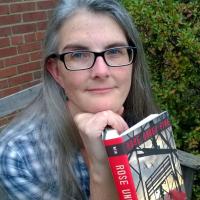Although the Ingalls family only lived in Walnut Grove for three years (on two different occasions — 1874–1876 and 1878–1879), the town has a strong connection to Laura and the Little House books because of its prominence in the TV series “Little House on the Prairie.” As we drove into the center of town, signs connecting the location to Laura abound, announcing “Walnut Grove, Childhood Home of Pioneer Author Laura Ingalls Wilder,” “Nellie’s Café” and “Ingalls Street.” But our first stop in Walnut Grove is dedicated to a thorough exploration of the Laura Ingalls Wilder Museum .
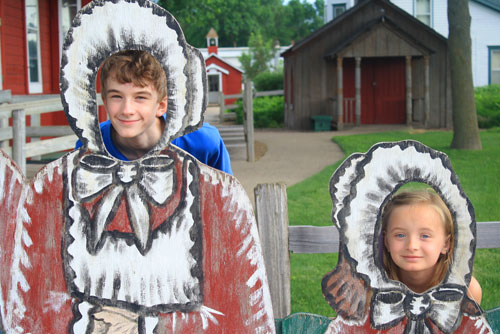
After taking advantage of the photo ops outside the Museum, we scoped out the souvenirs then headed for the eight buildings on the museum grounds. Here’s where we parted company. Breece and Avery scurried through several exhibits and buildings and were engrossed in dressing up and other hands-on activities long before Rachael and I could bear to move away from the first exhibit — an incredible collection of Garth Williams sketches. Each display included an original early sketch and the final illustration that appears in one of the Little House books. The sketches were complemented with some actual artifacts belonging to Laura along with many objects from that time period that were described in the books.
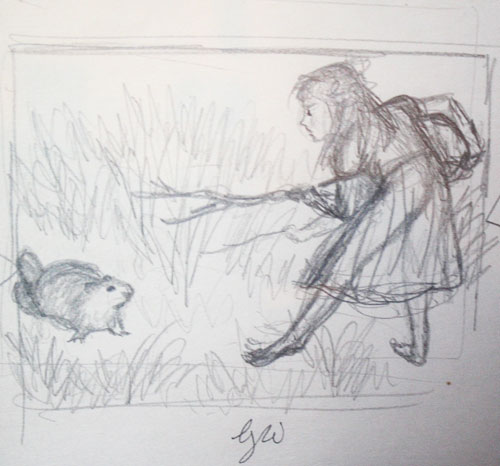
Rachael: What impressed me right away (after the Garth Williams sketches!) is that while this museum didn’t have very many things that actually belonged to the Ingalls, there was so much good information about how they were part of the Walnut Grove community. For example, while living in Walnut Grove, Mary Ingalls went blind at the age of 14. The exhibit about Mary’s blindness was filled with newspaper clippings from the Currie Pioneer and the Redwood Gazette that chronicled her illness and convalescence. The concern for Mary was very touching, though sometimes a bit strange for modern sensibilities: “Although entirely blind, she is very patient and submissive.”
In describing the Ingalls’ role in the community in On the Banks of Plum Creek, we know they were active in the church — Pa gave his boot money for the church bell — and that the girls went to school. But Wilder makes her family seem much more isolated and far from civilized society than they must have been to have so much ink dedicated to her sister’s illness.
Janet: One section of the Depot Building was a special treasure for those Wilder fans that delight in the television series “Little House on the Prairie.” A massive bulletin board featured scenes from the show and a TV monitor ran continuously, pouring forth Michael Landon and his troupe as they created their own Little House sagas. In addition, Walnut Grove annually hosts the Wilder Pageant, which often includes special events with cast members. This year, the show’s 40th anniversary year, the reunion lineup included ten of the actors and actresses in the series, ranging from Allison Aragrim (Nellie Olson) to the twins Wendi and Lee Turnbaugh who played Grace Ingalls.
The TV series, as well as feature-length films based on the Little House books, offer a variety of opportunities for both comparison/contrast writing and discussion and creative productions of students’ own making. For in-depth comparison/contrast activities, students could analyze Laura’s life, her books and the media versions of her story. Having students choose a scene or part of Wilder’s life not found in the film or TV series and work together to create their own video version would enhance understanding of the elements in both the novel and the video, such as plot, flashback, point of view, and mood.
Another way to bring Wilder’s story to life is through living literature or living history. For over 30 years, I’ve donned period costumes to become famous women from history and literature. Laura Ingalls Wilder was one of the first authors I portrayed, and she remains a favorite of both adults and children. However, audiences today frequently have difficulty in adjusting mental pictures that conflict with the images and story lines on television. Time and again, young and old bemoan the fact that Laura’s sister Mary did not get married, did not teach school, and continued to live with Ma and Pa.
Engaging students in literature using a living history or living literature approach allows them to understand authors and stories more fully, to present history or literature in a different persona, and to make judgments about the values and opinions of the writers or the characters presented. An entire class could be involved in presentations of Laura Ingalls Wilder, with each student presenting a segment of her life from childhood to widowhood. While costumes and props help students get into and stay in character, the true benefits of the activity arise when the student consistently presents another’s world.
Breece: At this museum, there were lots of things for mom (Rachael) and Nama (Janet) to look at. But there were also things to do too. There was a whole building set up with spaces like a general store and post office so you could learn about the business of commerce on the prairie, but in a fun way since you could pretend work at these places. I was running the store and Avery was running the post office that was also the bank. But the cash register was very old and didn’t really work. And we didn’t have any customers! There was also a sod house. This one looked more like the one in the On the Banks of Plum Creek book. It had grass growing all over it. The good thing about this museum was that there were lots of different buildings to explore and you could always go ride on the big plastic horse outside if you got bored.
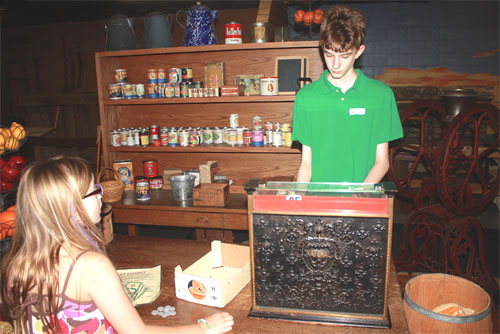
Avery: The classroom in the small school looked just like what it would really look like, not vague like others we saw. The size seemed accurate. The houses we’d seen seemed teeny tiny that the small-scale school seemed the right size. The classroom had little pamphlets with what students would learn a long time ago. I was the teacher and asked questions like, “Each orange was 5 cents. If you bought 4 of them how much change would you have left from 25 cents.” On the teacher’s desk was a laminated answer sheet. (That didn’t look like old paper at all!) My family of students had different responses. Breece tried to look at the answer key, so I didn’t call on him. Grandma and Aunt Rachael got all their answers right.
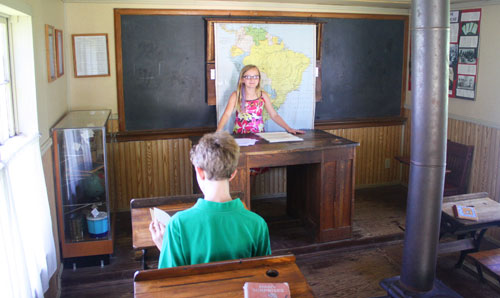
It’s easy to spend hours in this museum — dressing up, and scrutinizing documents, pictures, and videos — plus serendipitous exhibits like the more than 250 dolls that fill one alcove or the jail that was far from comfortable, according to Avery. But we were anxious to see Plum Creek and wiggle our toes in the water, hoping to avoid any large crabs .

